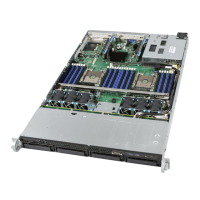Intel® Server Board S2600WF Product Family Technical Product Specification
113
circular, any command that results in an overflow of the SEL beyond the allocated space will overwrite the
oldest entries in the SEL, while setting the overflow flag.
12.3 Sensor Monitoring
The BMC monitors system hardware and reports system health. The information gathered from physical
sensors is translated into IPMI sensors as part of the IPMI sensor model. The BMC also reports various
system state changes by maintaining virtual sensors that are not specifically tied to physical hardware. This
section describes general aspects of BMC sensor management as well as describing how specific sensor
types are modeled. Unless otherwise specified, the term “sensor” refers to the IPMI sensor-model definition
of a sensor.
• Sensor scanning
• BIOS event-only sensors
• Margin sensors
• IPMI watchdog sensor
• BMC watchdog sensor
• BMC system management health monitoring
• VR watchdog timer
• System airflow monitoring sensors - valid for Intel® server chassis only
• Fan monitoring sensors
• Thermal monitoring sensors
• Voltage monitoring sensors
• CATERR sensor
• LAN leash event monitoring
• CMOS battery monitoring
• NMI (diagnostic interrupt) sensor
12.3.1 Sensor Re-arm Behavior
12.3.1.1 Manual versus Automatic Re-arm Sensors
Sensors can be re-armed either manually or automatically. An automatic re-arm sensor re-arms (clears) the
assertion event state for a threshold or offset if that threshold or offset is de-asserted after having been
asserted. This allows a subsequent assertion of the threshold or an offset to generate a new event and
associated side-effect. An example side-effect is boosting fans due to an upper critical threshold crossing of
a temperature sensor. The event state and the input state (value) of the sensor track each other. Most
sensors are of the auto-rearm type.
A manual re-arm sensor does not clear the assertion state even when the threshold or offset becomes de-
asserted. In this case, the event state and the input state (value) of the sensor do not track each other. The
event assertion state is "sticky". The following methods can be used to re-arm a sensor:
• Automatic re-arm – Only applies to sensors that are designated as auto re-arm.
• IPMI command – Re-arm sensor event.
• BMC internal method – The BMC may re-arm certain sensors due to a trigger condition. For example,
some sensors may be re-armed due to a system reset. A BMC reset re-arms all sensors.
• System reset or DC power cycle – Re-arms all system fan sensors.
12.3.2 Thermal Monitoring
The BMC provides monitoring of component and board temperature sensing devices. This monitoring
capability is instantiated in the form of IPMI analog/threshold or discrete sensors, depending on the nature
of the measurement.

